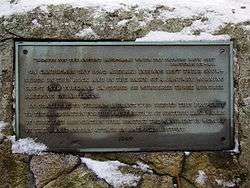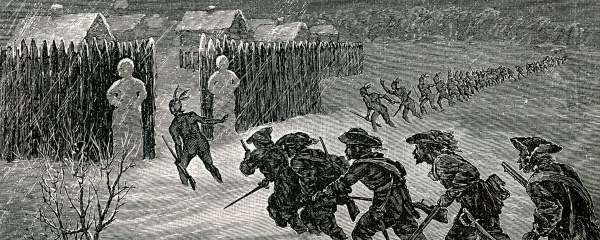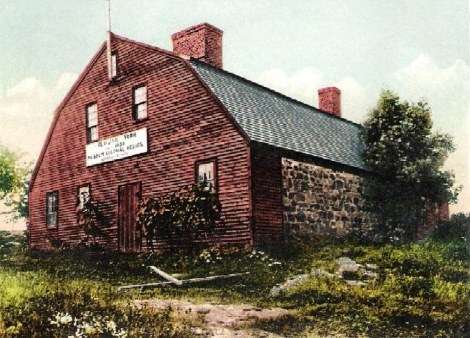One week after two girls in Salem, Mass., begun having strange fits, the Candlemas Massacre wiped out the village of York in the District of Maine.
On a snowy night, a French and Indian war party traveled on snowshoes to the village outskirts and waited until just before dawn. Then they killed or captured about 150 people and burned almost all of their houses.
The Candlemas Massacre took place in the midst of King William’s War, one of the French and Indian wars fought intermittently in North America from 1689 to 1763.
The massacre would have an impact on subsequent events, including the Salem witch trials. It would also influence the next French and Indian War, known as Dummer’s War or Father Rales’ War.
Sorrowfull Tideings
The Rev. George Burroughs in nearby Wells described the Candlemas Massacre: ‘Pillours of Smoke, the rageing of the mercyless flames, the insultations of the heathen enemy, shooting, hacking… & dragging away others.’
He concluded with an accusation that foreshadowed the Salem witch trials:
The ‘Sorrowfull tideings’ from York, wrote Burroughs, showed ‘God is still manifesting his displeasure against this Land.’
York, Maine
English colonists had settled Maine under a charter granted to Fernando Gorges. York was successively known as Bristol, Agamenticus and, in 1642, as Gorgeana. Gorges died 10 years later. Massachusetts Bay Colony then absorbed Maine and renamed the settlement York.
Massachusetts officials wanted to push Maine’s boundaries beyond Casco Bay. However, New France – now Canada – claimed Maine too.
Gov. Edmund Andros in 1686 ordered a raid on the home of Baron Saint-Castin, a Frenchman who founded Castine, Maine. Saint-Castin retaliated by destroying the English fort at Pemaquid in 1689.
In 1692, Madocawando, sachem in the Penobscot band of Wabanakis, led the Candlemas Massacre. He had a reputation for his courage, his hatred of the English and his son-in-law – Baron Saint-Castin.
Early Warnings
The Candlemas Massacre didn’t take York by complete surprise.
Shubael Dummer, founder of York’s First Parish Congregational Church, resisted warnings to leave the village because of the dangerous unrest.
Wrote Cotton Mather,
Though solicited with many temptations to leave his place, when the clouds grew thick and dark in the Indian hostilities, and was like to break upon it, he chose, rather, with a paternal affection to stay amongst those who had been so many of them converted and edified by his ministry.
The residents of York may also have seen paper money, the first in North America, issued by Massachusetts to pay for the war with the French and Indians.
The Candlemas Massacre
On Jan. 24, 1692, Madocawando and French missionary Louis Pierre Thury led as many as 300 French and Wabanaki on snowshoes from Canada to York. Before dawn, they piled their snowshoes next to a large rock and crept into town. (A plaque marks the spot today.)
“The Inhabitants were in their unguarded Houses, here and there scattered, Quiet and Secure,” according to a contemporary account. Taking the houses one by one, the warriors killed the inhabitants and livestock, captured others and burned most of the buildings.
Indians shot Shubael Dummer at his own front door while he tried to escape on his horse. They stripped him of his clothes and mutilated his body. Then they captured his wife, Lydia, and their small son and forced them to march through the snow to Quebec.
“On the next Lord’s Day a full welted savage, purposely to deride the ministerial character of Mr. Dummer, put on his garments, and then stalked about in the presence of the distressed captives some of whom belonged to his church, to aggravate their feelings,” according to historian William Williamson.
Aftermath
When Indians burst into the Moulton house, four-year-old Jeremiah had hidden under the bed. Amid screaming and scuffling the Indians buried a hatchet in his mother’s head, then tomahawked his father. Jeremiah watched as the Indians scalped his parents. After they left he stayed under the bed until the house caught fire. He then ran from the house toward a group of men who turned out to be Indians. They tied him up along with the others.
Capt. John Floyd with a small group of militiamen rushed to the scene of the Candlemas Massacre from Portsmouth, N.H. They discovered about 18 houses burned, the remainder rifled and the dead lying about. The attackers left standing the gaol, the meeting house and the garrison.
Floyd and his men buried 48 people in a mass grave along with an unrecorded number of small children.
The captives were taken to Canada, where some were ransomed by Capt. John Alden Jr., son of John Alden and Priscilla Mullins of the Plymouth Colony. The Indians set Lydia Dummer free, but separated her from her son. She traveled to Quebec three times to find him, but never saw or heard from him again.
Jeremiah Moulton
Jeremiah Moulton reappeared during Dummer’s War, named after Shubael Dummer’s nephew William, acting governor of Massachusetts. Some called it Father Rale’s War, after Father Sébastien Rale who led an alliance of Wabanaki Indians on the side of New France.
In 1724, Moulton led 200 men to the Wabanaki settlement of Norridgewock to kill Father Sebastian Rale and slaughter the Indians. The Englishmen succeeded in killing Rale and 80 Abenakis, including two dozen women and children.
Moulton returned to York and became sheriff. In 1719 he rebuilt the gaol with timbers left from the one that was left standing. Today it still stands, the last known public building of the colonial era.
Later in 1692, John Alden and John Floyd were accused of witchcraft in the Salem witch trials because of their involvement with the Candlemas Massacre. Both managed to escape execution.
This story was updated in 2022.







6 comments
Thanks for this story. Captain John Alden Jr. is my eighth great grandfather and I had no idea about his participation in this event.
[…] the minister of the Second Church of York, he was greatly esteemed, according to an epitaph. He was […]
[…] Image Credit – New England Historical Society […]
[…] then spent his final days in York, Maine. He died in […]
[…] https://newenglandhistoricalsociety.com/candlemas-massacre-salem-witch-trials/ […]
[…] warfare continued, with one of the most dramatic attacks on York in February 1692. Called the Candlemas Massacre, it ended with 50 dead and 100 […]
Comments are closed.